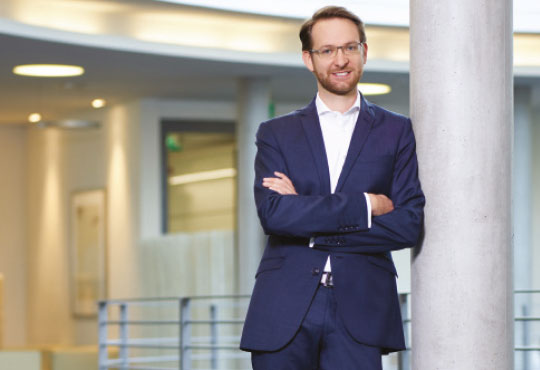Put Your Customer First When Doing Your Digital Transformation
Thomas Saueressig, Chief Information Officer, SAP SE
 The parameters for businesses to survive in an ever-evolving environment have changed. When you consider some of the most successful companies of the last years, for example in transportation software, accommodation or social media, you will find that agility and adaptiveness are key. Disrupting markets is possible by embracing new technologies in clever ways and thus developing innovative business models, that put the customers first, offering them exceptional and never-before-seen experiences. Just look at the top 10 global companies from 2006 and their successors in 2016. Seven of them are new. In the same time 88% of the Fortune 500 have either disappeared, or merged, or contracted.
The parameters for businesses to survive in an ever-evolving environment have changed. When you consider some of the most successful companies of the last years, for example in transportation software, accommodation or social media, you will find that agility and adaptiveness are key. Disrupting markets is possible by embracing new technologies in clever ways and thus developing innovative business models, that put the customers first, offering them exceptional and never-before-seen experiences. Just look at the top 10 global companies from 2006 and their successors in 2016. Seven of them are new. In the same time 88% of the Fortune 500 have either disappeared, or merged, or contracted.
Make the next step in your digital journal
This shows that, as a long-standing company, you need to move forward with your digital transformation. This is what customers expect from you and what is vital to them. Businesses on their way to digitization can learn very much about what concerns their customers. The focus of a Chief Information Offer must be on both customer experience and employee experience.
For large enterprises like SAP and others, it has been the path to follow for some time. The focus lies on empathy: Show your customers that they matter, that all the steps you undertake are made to help them and satisfy their needs and wishes. How do you do this? Among multiple courses suitable for this, one of them is a customer-centric IT organization.
Global CIOs spearhead these developments. That may help understand the customers’ experiences literally every day – and clearly fosters the transformation of business models. For example, if the business of a software provider transforms from a model based largely on license and maintenance fees for on-premise software to one based on subscriptions and service consumption in the cloud, certain principles must be emphasized to make the process successful – principles such as:
• Put Users in the Center: Concentrate on the people who use the software and services you offer. Analyze how software is used and what is requested by the customer.
• Promote Agility: Make change an integral part of your business and encourage your employees to embrace it, use a platform that supports this agility and helps you to quickly improve and develop new solutions.
• Value the Cloud: Software-as-a-service and infrastructure-as-a-service offerings help you speed up deployment and minimize capital expense.
• Think of Your Business: Think of what business processes can be improved and thus enable your company to constantly achieve more. Using machine learning and other leading-edge technologies offer great potential.
Following these principles means to understand that the only way to increase the productivity of your company is to increase the productivity of your people. This requires facilitating mobile work through cloud and enterprise mobility capabilities, for example, so employees can work and easily access information anywhere they need to. SAP, for example, has more than 200 cloud apps on its cloud platform, including more than 80 different mobile apps.
Moreover, it’s enormously helpful to pave the way for the use of chatbots and other new support technologies. Newly developed apps should include simple ways to directly share feedback with the app owner in IT. On-demand and mobile access to trainings even provides the opportunity for ongoing education.
But, for a software vendor, what really drives your ability to empathize with customers is running your own software in your own organization. In fact, at SAP we only run software that our IT implemented and continues to support.
Openness to change
To be a successful transformer, you must foster experimentation and be open to change. Let your IT organization represent an internal pioneer, and have it implement your solutions with profound knowledge of you customers’ needs and a feedback loop into R&D. Identifying the best way to manage digital and business transformation creates a mutual benefit for both the company and its customers. Continuously pursuing this win-win outcome, let’s return to the importance of a positive mindset. It takes people who are broad-minded – people who have fun implementing software that fosters new business models. It’s the openness to change that drives success.
But that’s not the whole story. If people are supposed to be curious and motivated, they must not be afraid of making mistakes from time to time. Not trying means not finding out – and if you prove wrong, just try again. Innovation needs a culture of errors and – of course – a capable error management, too. Perfectionism may be tempting in theory, but really doesn’t work if you’re into inventing new solutions and tackling things a different way.
The need for speed – and permanent communication
New developments take their time: this is not true anymore. Digitally transforming businesses and peoples’ lives seems to happen with ever accelerating speed. That’s why companies must keep pace. In former years, a business took 20 years from its foundation to its first billion in market capitalization. Today, it’s only three and a half years. That means: The next potential competitor will arrive in just four years – not too much time at all, but high time for a customer-centric IT organization.




